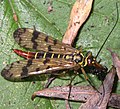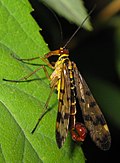| Line 10: | Line 10: | ||
| superordo = [[Endopterygota]] | | superordo = [[Endopterygota]] | ||
| ordo = '''Mecoptera''' | | ordo = '''Mecoptera''' | ||
| − | | | + | | ordo_authoritjkkjl';' |
| + | ; | ||
| + | |||
| + | |||
| + | |||
| + | ;;;mjhgfdsdfghjkl;sdfghjkl;y = Hyatt & Arms, 1891 | ||
| subdivision_ranks = Families | | subdivision_ranks = Families | ||
| subdivision = | | subdivision = | ||
Revision as of 15:14, 21 November 2006
Mecoptera (from the Greek: meco- = "long", ptera- = "wings") are an order of insects with about 600 species worldwide. Mecoptera are sometimes called scorpionflies after their largest non-flea family, Panorpidae, in which the males have enlarged genitals that look similar to the stinger of a scorpion. The Bittacidae, or hangingflies, are a prominent family of elongate insects known for their elaborate mating rituals, in which females choose mates based on the quality of gift prey offered by various males.
Recent DNA evidence indicates that fleas, which are traditionally considered to be also of order level as the order Siphonaptera, are instead highly specialized Mecoptera. There is some morphological evidence for the grouping of Siphonaptera and Mecoptera Boreidae. Two synapomorphies are the production of resilin, a very flexible and springy type of cuticle, and a reversion to panoistic ovarioles. Grouped together with the fleas, Mecoptera would have about 3000 species.
References
- Grimaldi, D. and Engel, M.S. (2005). Evolution of the Insects. Cambridge University Press. ISBN 0-521-82149-5.
- Template:Cite journal [1]
External links
de:Schnabelfliegen fr:Mecoptera lt:Skorpionmusės no:Skorpionfluer pl:Wojsiłki sv:Näbbsländor zh:長翅目



